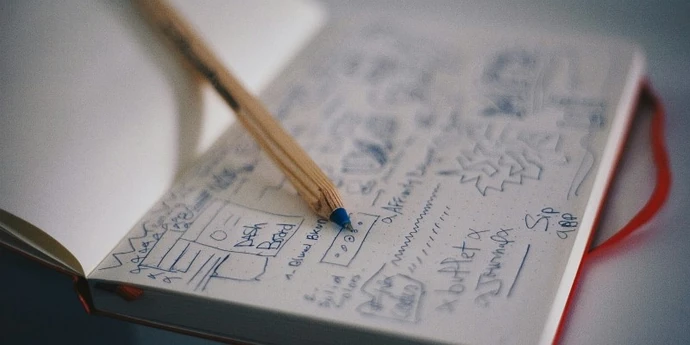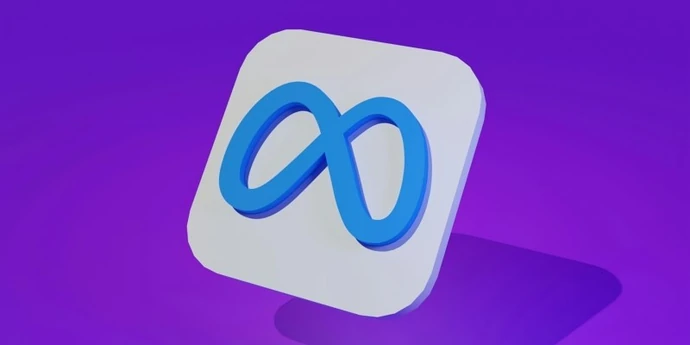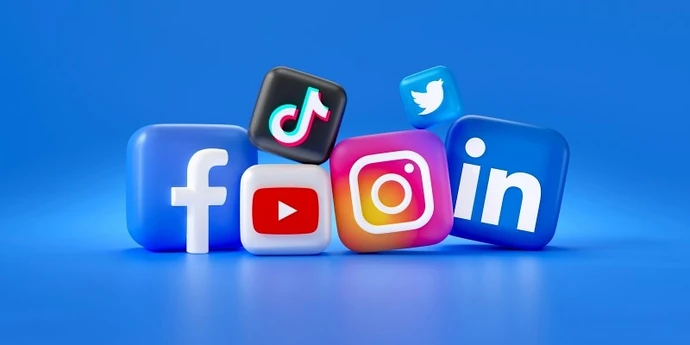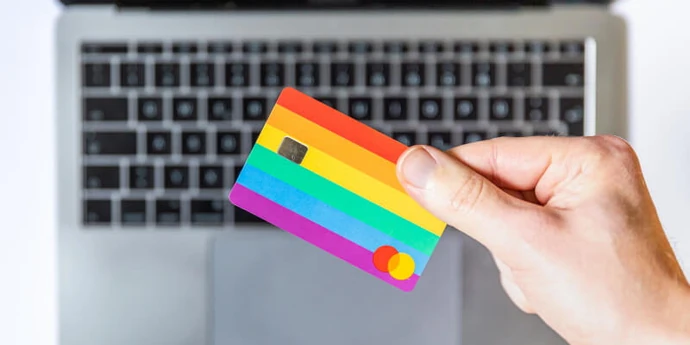Technical product manager interview questions can be tough, but with the right preparation you can greatly increase your chances of landing an offer.
Below are ten extremely typical technical product manager interview questions, with example answers for each question.
You'll also find a list plenty more typical questions for you to practice with, as well as detailed advice on how to answer
Here’s an overview of what we will cover:
- 10 typical technical product manager interview questions (with answers)
- More technical product manager interview questions
- How to answer technical questions
- How to practice technical questions
Let's go!
Click here to practice 1-on-1 with FAANG ex-interviewers
1. 10 typical technical product manager interview questions (with answers)
The questions below are pretty typical in technical product manager interviews at top tech companies like Google. We recommend working through the list ahead of your interview and following our links to dive deeper into a category when necessary.
1. Explain how [something technical] works in very simple terms
If you’re applying for a technical product manager role, you can expect a technical explainer question like this one in order to assess how well you understand relevant technical concepts to the position you’re applying for.
It also tests your ability to communicate clearly when dealing with complex topics, as you’ll often need to explain technical needs or problems to non-technical stakeholders. Are you able to moderate your vocabulary and metaphors so that they can better understand the concept at hand?
Below is a shortened sample answer to the question, “Explain how the internet works.”
Example answer: Explain to my grandfather how the internet works
Clarify
To reduce the scope of the explanation, you can start with, “The internet is composed of many complex elements. I could talk about network connections, blockchain technology, specific web services, etc. But the most fundamental feature of the internet is probably that websites can be accessed by typing a URL in a browser, so this is what I suggest we focus on.”
Explain step by step
Take some time to write out your thoughts, then walk the interviewer through the steps:
- The Client browser uses the URL (e.g. example.com) to find the website’s IP address, which is either stored in local memory or found with a DNS lookup. Here’s a metaphor to help explain: a DNS resolver is like a big phone book matching URLs and IP addresses. If you wanted to call “John Smith” on the phone, first you would need to find his number in the phone book.
- Next, the browser uses the IP address and queries the internet for the website’s data. This is like if you dialed John Smith’s number, then the phone company would make a connection between your phone lines.
- Then the website’s Server sends appropriate data (e.g. an index.html file) back across the internet. To continue the metaphor, when John Smith answers and says hello, his voice is translated into an electronic signal that’s passed through the phone lines.
- Finally, the website’s data reaches the browser, which then displays a visual interpretation of that data. This is like your phone’s speaker turning the electronic signal into John Smith’s voice again.
Conclude and discuss
After going over the above, you could conclude by saying, “So, typing a URL into the address bar of a browser works a lot like making a phone call. Information is transferred back and forth between two connection points, and the transferred information needs to be interpreted by the receiver.”
For more details on how to approach technical explanations and how to structure your answer, skip to section 3 below.
2. Tell me about some hardware you used recently. How would you improve it?
This is a common technical question to face in PM interviews because it serves various purposes for the interviewer.
First, it assesses how well you understand the technologies you work with or use in your everyday life.
Secondly, it tests your ability to think critically about these products and identify shortcomings, which is an important skill for a PM.
Third, it tests your ‘product sense’. Do you have a good intuition as to what makes a product successful? Are you able to translate an understanding of technical shortcomings into a strategic opportunity?
Let’s see an example answer to this question.
Example answer: Tell me about some hardware you used recently. How would you improve it?
(Clarify)
"Sure, is it okay to use an example from outside work? Great, okay well recently, I used a smart home security camera system that had both positive aspects and areas for improvement.
(Explain step-by-step)
There were three main areas where I would have wanted to improve the product.
- Integration: The system could be enhanced by integrating with other smart home devices like smart locks and motion sensors. This would create a more automated and comprehensive security ecosystem.
- Mobile app UI: Improving the mobile app's user interface with better navigation and user-friendliness would enhance the overall user experience.
- Night vision upgrade: Upgrading the night vision technology would significantly improve the camera's performance during nighttime surveillance.
(Conclude and discuss)
So to conclude, these improvements would have given the product a differential in the market against competitors and as a customer I would have certainly had a greater satisfaction with the product."
3. Why do you want to work here?
No matter what type of product manager role you’re applying for, you can expect to be asked this question. Interviewers want to see that you know about the company and that you’re excited to work for them (for the right reasons, not just the money).
Don’t go into your interview without a well-prepared answer. For help, see our “why do you want to work here?” interview question guide. It’s written with Google in mind but the principles we talk about can be applied to any company.
Example answer: Why do you want to work at Amazon?
“I want to work at Amazon for three reasons.
First, I admire Amazon’s customer obsession leadership principle. This is something I've experienced first-hand when dealing with Amazon’s customer support, and it's also a principle I've been pushing at my current company. I was able to spearhead an initiative to update our support ticket system based on customer feedback, which decreased complaints by 20%.
Second, one of my co-workers, Robert Hidayat, used to be a Senior Product Manager at Amazon in Seattle. He has really great things to say about the company and often talks about how much he learned about product management there. I would love to be immersed in that environment.
Third, I've spent the last five years of my career in the streaming space, producing videos on my own as a hobby and working for a content production startup. I greatly admire the Amazon Video product and how it is positioned in the market, and I’d be excited to bring my experience to the Amazon Video team.”
4. How does our product work? (eg. How does Uber work?)
As a product manager or technical product manager you don’t need to be a developer but you need to understand how technology works. You should be prepared to give an interviewer a reasonably accurate overview of the end-to-end process behind their app or product.
Let’s take Uber as an example. Ahead of your interview you should be ready to give an overview of the step-by-step process that occurs when a customer requests a ride
Example answer: How does Uber work?
(Clarify)
“Sure, obviously Uber has various products, UberEats, UberFreight, etc, but if it’s okay with you I’ll just focus on the ride-hailing part of Uber? Okay great.
(Explain step-by-step)
Okay so, step 1: users open the Uber mobile app and enter their destination. The app uses GPS to identify the user's location automatically or allows manual input. Users can see the available ride options, estimated fares, and the approximate arrival time of nearby drivers.
Step 2: once a ride request is confirmed, the app sends the request to nearby Uber drivers. The drivers have the option to accept or decline the ride based on their availability and proximity to the user. The user is notified when a driver accepts the request.
Step 3: users can track the driver's real-time location on the app as they approach the pickup point. The app provides details such as the driver's name, vehicle model, and license plate number for easy identification.
Step 4: during the trip, the app displays the estimated time of arrival and updates the fare in real-time based on factors like distance traveled and time spent in transit.
Step 5: after reaching the destination, the fare is automatically charged to the user's registered payment method (credit card, PayPal, or other payment options). Users have the option to rate their ride experience and provide feedback about the driver and overall service quality.
Step 6: Uber takes a commission from the fare, and the rest goes to the driver. Drivers' earnings may vary based on factors such as the time of day, surge pricing (during peak demand), and distance traveled.
(Conclude and discuss)
So that’s obviously quite a basic overview of what happens when a ride request is made. Would you like me to go into more detail on any particular part of that process?”
If you’re a technical product manager, the interviewer will probably ask you to dive in and give a detailed technical explanation of what’s going on behind-the-scenes, like in this mock interview “How does Google Docs work?”
Alternatively, the interviewer might turn this into a much broader discussion about the product. Do enough research to make sure you have a basic understanding of the product's value proposition, its features, the target audience, and the industry it’s in.
5. Tell me about a time you led a team
Leadership skills are core to any product manager role, technical or otherwise.
If you don’t have experience in leadership positions, consider using examples from outside the workplace. The requirement here is to show that you’re resilient, capable of owning a problem, and able to align people around you towards a common goal.
For common behavioral questions like this, we recommend using the SPSIL framework. To learn more, check out our guide to answering behavioral interview questions.
Example answer: Tell me about a time you led a team
(Situation)
"I spent three years working at a small start up, and after an initial period of rapid growth, revenue dropped off and we started losing money.
(Problem)
I was leading a team of five, and understandably people were extremely worried about their jobs. I also had pressure from the CEO to implement cost-cutting and revenue-generating measures that would help us get back to break-even as soon as possible.
(Solution)
My primary focus was on keeping the team motivated and productive, even in the face of uncertainty. My first action was to schedule a meeting to specifically discuss the situation and provide an honest and transparent overview of what was happening.
I acknowledged the challenges that the company was facing, but that our team was essential to the company's success. I said that if they had any questions they could always ask me. We also came up with a list of team actions we could take that would reduce costs, and over the next 6 months I arranged bi-weekly updates with the CEO to show how we were progressing.
(Impact)
Through these actions my team played a major part in getting the company back on track, and I made sure this was visible to the CEO. There were no lay-offs in our area and morale and productivity stayed strong.
(Lessons)
It was a difficult experience to go through but I learned that when you’re managing a team, constant communication is vital in a crisis. People always have doubts and hypothetical scenarios you hadn't even thought of, and it’s really useful to provide a space where you can listen to them, show empathy and give them a more accurate picture of what’s going on, even if that picture is incomplete.”
6. What’s your favorite product and why?
This is one of the most common questions in product manager interviews. If you’re a technical product manager, you can suggest technical improvements that will improve how the product works.
It doesn’t really matter which product you pick, the key is giving some good reasons as to why, and structuring your argument properly.
Watch the video below to see how an ex-Google PM recommends answering this question.
For a deeper dive into this extremely common question, check out our specific guide: “How to answer the favorite product question in PM interviews.”
7. Explain X engineering concept
Depending on the role you’re applying for, you may be asked questions to see if you have a basic understanding of key engineering concepts. Google, for example, requires all junior product managers to have a technical background, so it sometimes tests candidates with questions like this.
The depth of technical detail you need to go into in your answer will very much depend on the technical expectations of your role. In most cases, the interviewer will just want to see that you’re capable of discussing these kinds of concepts with the engineering team and bearing them in mind when making product decisions.
Example answer: Explain the concept of Big-O notation
"Big-O notation is a way to measure how fast a computer program or algorithm gets slower as the amount of data it handles increases. It helps us understand how efficient our program is and how it performs with larger tasks.
I think of it as like a scale that shows if our program can handle big tasks smoothly or if it will start to slow down a lot as the workload gets bigger. The lower the number in Big-O notation, the better and faster our program will be with larger tasks.
As a product manager, it's important to consider the Big-O notation when choosing algorithms, to make sure our product can handle bigger challenges effectively."
8. Tell me about a time you tackled a technical problem
Here the interviewer wants to see evidence that you have some experience dealing with technical issues, and that you have the sufficient technical understanding and vocabulary to work with the engineering team to find a solution.
For all ‘tell me about a time’ questions, we recommend using the SPSIL framework to structure your answer. Let’s see how that might look in the example answer below.
Example answer: Tell me about a time you tackled a technical problem
(Situation)
"At my previous company, we shipped a hardware product to customers all around the world.
(Problem)
However, the product had a latent bug, and we were getting a high return rate and customer complaints.
(Solution)
First I worked with the customer support team to understand what was happening and recognize that we needed to scale the problem and put significant resources into solving it. I then pulled in members from the engineering team and we performed a root cause analysis, enabling us to identify the cause as a faulty chip in the hardware, made by an external manufacturer.
We made them aware of this and they were able to correct this fault, but of course we still needed to fix the thousands of units that had already been shipped.
I asked the engineering team to prioritize finding a solution. They carried out some ideation sessions and eventually, with lots of trial and error, they were able to come up with a software solution that would mask the hardware problem for those units already shipped so that consumers wouldn’t notice.
(Impact)
As we were able to find and fix the bug relatively early, a hugely negative impact for the company was avoided and the cost was relatively low.
(Lessons)
It served as a reminder that, no matter how much Q&A you do, something can always go wrong. It’s really important to take notice of small signals from the customer support team, to spot a problem before it becomes a really big, unsolvable one. And it’s also a key part of my job to have relationships with all these different teams but above all, the engineering team, so that in a crisis I can work quickly and effectively with them.”
This example answer is taken from a mock interview with an ex-Google PM. Click here to watch it in full.
9. How do you communicate with the engineering team?
As a technical product manager or regular product manager, interviewers will want to know that you will be able to communicate effectively with the engineering team.
The question could be framed in many different ways - such as:
- "Tell me about a time you had to push back against the engineering team.”
- "Tell me about a time you created a roadmap with an engineer"
Check out the video below for more advice on how to deal with this type of question.
10. Design an algorithm for X system
Google sometimes asks questions like these. Examples might be "Design an algorithm for an elevator system" or "Design an algorithm for a self-driving car".
These questions can seem intimidating. But they're not actually expecting you to come up with a working algorithm. Instead, the interviewer wants to know how you would structure a technical product offering (e.g an API) for a particular service.
So you'll want to consider what goals the algorithm should have, what are the use cases, what metrics will you establish, what requirements should be prioritized, etc.
Take a look at this mock interview below where a candidate is asked to design an algorithm for Disney+.
2. More technical product manager interview questions
Here is a list of technical questions that were asked in PM interviews at Google and Amazon, according to data from Glassdoor.com:
- Explain recursion to my grandmother
- Explain what cookies are to my grandfather
- Explain what APIs are to a non-technical person
- Explain the concept of "protocol" to a 4-year-old child
- Explain the difference between http and https
- Explain what happens when executing mergesort
- Explain the difference between C++ and Java
- Explain how a DNS works
- There is a latent bug in hardware already shipped. What do you do?
- How does Google Calendar work?
- What technologies would you use to build a live stream video service?
- When are Bayesian methods more appropriate than "Artificial Intelligence" techniques for predictive analytics?
- How would you most efficiently store large images in a database?
- How would you get authentication to work across domains?
- How did you optimally query the database to get faster results
Of course, even if you're a technical PM, technical questions are only a small part of your interview. Read our guide to product manager interview questions for a complete overview of what to expect and how to prepare.
For behavioral interviews, check out our guide on PM behavioral interview questions for a list of common questions asked at top companies, along with sample answers.
If you're applying for an AI-focused PM role, our guide to AI PM interview questions has a list of commonly reported questions, expert insights, and a prep plan to help you get started.
3. How to answer technical interview questions
You can see that the most common type of technical question for a product manager to face is a technical explanation question.
For technical explanation questions it's important to structure your answer properly. So let's look at a framework to help you do that.
We developed the IGotAnOffer method below to help you give a clear and thorough answer to technical explanation questions. You can also use this framework for the "How would you..." hypothetical questions like those listed in the previous section.
The steps might sound abstract at first but bear with us as the example below will help make them tangible.
- Clarify: Many candidates skip this step and jump straight into answering the question. This is a big red flag for interviewers. Before starting to answer make sure you understand exactly what the interviewer wants you to explain by asking clarification questions. In addition, if the topic you were asked about is extremely vast you will need to narrow down and focus your explanation on the most important aspect of the topic.
- Explain step-by-step: Next, you should explain the technical concept step-by-step. When possible, use a metaphor to communicate your understanding of how it works. In this step, it’s ok to ask your interviewer for some time to structure your thoughts before delivering your answer.
- Conclude and discuss: Finally, you should provide a summary of your explanation. At this point the interviewer will most likely critique your explanation, which is perfectly normal. They might continue to ask for further details to assess the depth of your understanding. Some interviewers will also keep on asking questions until they reach a technical area which you don’t master. If you don’t know something you should therefore admit it.
3.1 Example question with answer: How does the internet work?
Now that you know how to approach Technical explanation questions, let's look at an example.
Try this question:
“How does the internet work?”
Answer
Step one: Clarify
The internet is a complex system with many features and we can’t realistically explain how all of it works in an interview. It’s therefore a good idea to clarify with the interviewer what specific features of the internet we should focus on.
To reduce the scope of our explanation, we might say something like, “The internet is composed of many complex elements. I could talk about network connections, blockchain technology, specific web services, etc. But the most fundamental feature of the internet is probably that websites can be accessed by typing a URL in a browser, so this is what I suggest we focus on. Is that what you have in mind too?”
Step two: Explain step-by-step
Let’s imagine the interviewer agrees that we should explain what happens when someone types a URL into the address bar of a web browser.
A this point, we would ask for a few seconds to gather our thoughts and to list the high level steps of what happens when a user queries a website. Once you’ve laid out your thoughts you can start walking the interviewer through the different steps.
When a user queries a website there are four systems involved:
- The device on which the user is typing the website’s URL. This is often called the "Client"
- The DNS resolver which is going to help us find the IP address of the website based on its URL
- The Server, from which we need to get the website data that needs to be displayed
- The internet which manages communications (e.g. queries, data, etc.) between the Client and the website’s Server
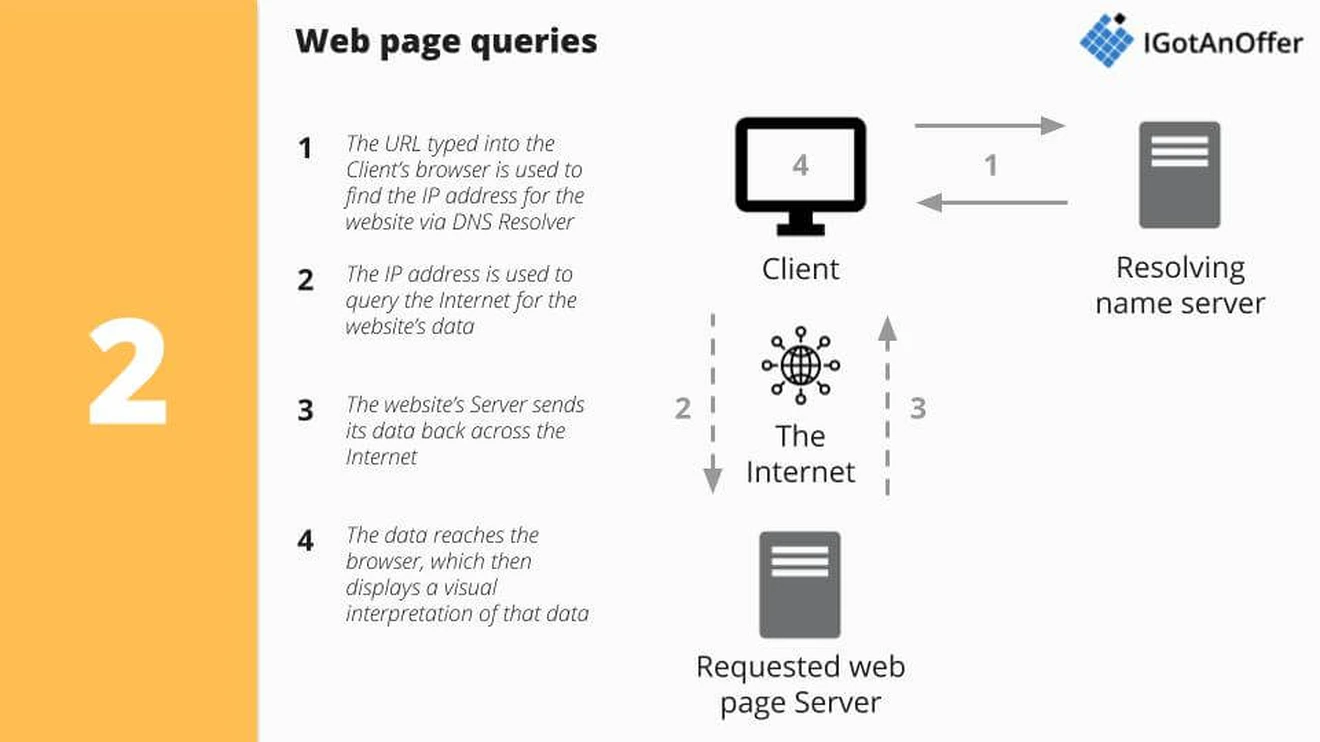
Here is what happens step-by-step:
- The Client browser uses the URL (e.g. example.com) to find the website’s IP address, which is either stored in local memory or found with a DNS lookup. Let’s use a metaphor for a second. A DNS resolver is like a big phone book matching URLs and IP addresses. If you wanted to call “John Smith” on the phone first you would need to find his number in the phone book.
- Next, the browser uses the IP address and queries the internet for the website’s data. This is like if you dialed John Smith’s number, the phone company would make a connection between your phone lines.
- Then the website’s Server sends appropriate data (e.g. an index.html file) back across the internet. In our metaphor, when John Smith answers and says hello, his voice is translated into an electronic signal that’s passed through the phone lines.
- Finally, the website’s data reaches the browser, which then displays a visual interpretation of that data. This is like your phone’s speaker turning the electronic signal into John Smith’s voice again.
Step three: Conclude and discuss
We would conclude by saying something like, “So, typing a URL into the address bar of a browser works a lot like making a phone call. Information is transferred back and forth between two connection points. Also, the transferred information needs to be interpreted by the receiver.”
Let’s imagine the interviewer is looking for more detail and says, “That’s an interesting explanation, but you glossed over DNS lookup which is a really important factor of the process you described. Can you explain more about that?”
Once again here we could ask for some time to list what happens step-by-step when a DNS resolver tries turning a URL into an IP address. Let’s assume we know a lot about how DNS resolvers work. Below is the information we would walk the interviewer through.
There are four major types of servers involved in DNS resolution:
- The Resolving name server receives the URL from the Client and is expected to send back an IP address. To find that IP address the Resolving name server communicates with three other servers: Root servers, Top Level Domain (TLD) servers, and Authoritative name servers.
- Authoritative name servers provide the IP address of specific websites (e.g. www.example.com). However, there are many Authoritative name servers, and the Resolving name server does not know which one to contact to find the IP address.
- A TLD server can point to the Authoritative name server of any website that ends with the particular domain extension it’s responsible for. As an example, a ‘.com’ TLD server stores the location of the Authoritative name server for all websites that end with ‘.com’. However, the Resolving name server does not know the location of the TLD server it needs to contact when it begins searching for the IP address.
- A Root server provides the location of TLD servers. The Resolving name server always knows where to find Root servers. So, contacting a Root server is the Resolving name server’s first step when searching for the IP address it’s trying to find.

Here is how the resolution works step-by-step:
- The Resolving name server queries a Root server, which points to the appropriate TLD server. Let’s use our phone book metaphor again. When calling John Smith, we would start our search for his number in the phonebook by deciding between the yellow pages for business numbers versus white pages for personal numbers. This is what the Root name server does for us.
- The Resolving name server then queries the appropriate TLD server, which points to the Authoritative name server. This would be like using the category and alphabetical sorting of the phonebook to find the specific page that lists all the “Smiths.”
- The Resolving name server then queries the appropriate Authoritative name server, which will provide the website’s IP address. There could be a lot of “John Smiths” listed in the phonebook, so you would use street addresses to determine the exact phone number for the specific John Smith you’re trying to call.
The interviewer interrupts and asks, “Another important element related to DNS is caching — can you explain how that works?”
At this point let’s assume we don’t know anything about caching, so we would say something like, “That’s really interesting, but I’m not sure how caching works in DNS processes. I would need to look into it a bit more to give an accurate answer.”
Remember, interviewers are likely to ask follow up questions until they reach the limits of your knowledge so it’s okay to say when you don’t know something.
4. How to practice technical questions ↑
With a lot to cover, it’s best to take a systematic approach to make the most of your practice time.
Below you’ll find links to free resources and four introductory steps that you can take to prepare for technical questions.
4.1 Study the company you're applying to
Get acquainted with the company you’ve applied to. In many cases, the product questions you’ll be presented with will be based on real-life cases the company is facing. If you’re applying to a specific team, study up on their products, the user, etc.
Take the time to find out which products you’ll most likely be working with, based on the job description, and research them. Look up relevant press releases, product descriptions, product reviews, and other resources in order to discuss what’s most important to the role: the company’s product.
If you'd like to learn more about a specific company's PM interviews, then we'd encourage you to check out our guide for that company below:
- Google product manager interview guide
- Facebook product manager interview guide
- Amazon product manager interview guide
- Microsoft product manager interview guide
- LinkedIn product manager interview guide
- Uber product manager interview guide
- Stripe product manager interview guide
- Lyft product manager interview guide
- Apple product manager interview guide
- TikTok product manager interview guide
- Coinbase product manager interview guide
- Airbnb product manager interview guide
- DoorDash product manager interview guide
- Nvidia product manager interview guide
- OpenAI product manager interview guide
- Oracle product manager interview guide
4.2 Learn by yourself
Learning by yourself is an essential first step. We recommend you make full use of the free prep resources on this blog and also watch some mock interviews on our product management YouTube channel. That way you can see what an excellent answer looks like
Once you’re in command of the subject matter, you’ll want to practice answering questions. But by yourself, you can’t simulate thinking on your feet or the pressure of performing in front of a stranger. Plus, there are no unexpected follow-up questions and no feedback.
That’s why many candidates try to practice with friends or peers.
4.3 Practice with peers
If you have friends or peers who can do mock interviews with you, that's an option worth trying. It’s free, but be warned, you may come up against the following problems:
- It’s hard to know if the feedback you get is accurate
- They’re unlikely to have insider knowledge of interviews at your target company
- On peer platforms, people often waste your time by not showing up
For those reasons, many candidates skip peer mock interviews and go straight to mock interviews with an expert.
4.4 Practice with ex-interviewers
In our experience, practicing real interviews with experts who can give you company-specific feedback makes a huge difference.
Find a product manager interview coach so you can:
- Test yourself under real interview conditions
- Get accurate feedback from a real expert
- Build your confidence
- Get company-specific insights
- Learn how to tell the right stories, better.
- Save time by focusing your preparation
Landing a job at a big tech company often results in a $50,000 per year or more increase in total compensation. In our experience, three or four coaching sessions worth ~$500 make a significant difference in your ability to land the job. That’s an ROI of 100x!







